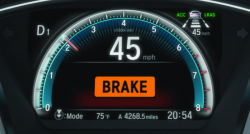
— A Honda sudden braking class action lawsuit alleges 2019-2022 Honda Insight and 2019-2022 Honda Passport vehicles are equipped with defective automatic emergency braking systems.
The sudden unintended braking lawsuit was filed a few weeks after the National Highway Traffic Safety Administration opened an investigation into sudden braking in 2019-2022 Honda Passport SUVs and 2019-2022 Honda Insight cars.
Honda calls its technology the Collision Mitigation Braking System (CMBS).
"Featuring a radar transmitter mounted in the front grille trim, CMBS™ can determine the distance and closing speed of obstacles ahead of you. If the radar and high-resolution camera detects another vehicle or a pedestrian in front of the car, it will provide both visual and audio warnings. If you do not immediately respond, the system will automatically apply the brakes."
Massachusetts plaintiff Andrea Sivakova owns a 2021 Honda Passport Sport and allegedly "has experienced sudden, unintended braking in her vehicle numerous times."
The plaintiff doesn't say if she took her vehicle to Honda or any mechanic to have the alleged problem checked, diagnosed or repaired.
The Honda sudden braking lawsuit alleges the Passport and Insight vehicles suddenly brake while driving even though no forward objects, vehicles or pedestrians are in the road. The plaintiff contends automatic emergency braking engages at any time, including in the middle of traffic.
According to the sudden braking class action lawsuit, what is supposed to be a safety feature to protect consumers is really a safety hazard.
The technology is allegedly not ready for real-world use, and although the plaintiff claims owners were not warned of potential sudden braking, the Insight and Passport owner's manuals describes the system limitations.
Honda does warn vehicle owners about the limitations of the automatic emergency braking systems.
The Insight and Passport owner's manuals warn drivers the braking systems might activate “when there is no vehicle ahead,” and the manuals list conditions where sudden braking may occur.
- Driving through curves
- Driving “under low or narrow bridges”
- Driving over speed bumps, steal plates or train tracks
- Driving past traffic signs or guard rails
Though the Honda owner's manuals warn drivers of possible sudden braking from the automatic emergency braking systems, the owner who sued asserts the warnings, "did nothing to adequately warn people about the Sudden Unintended Braking Defect."
"Honda’s CMBS system is technologically underdeveloped and relies on cheap components that are unable to reliably perform the one job they are intended to do: namely, adequately differentiate common road features with true obstacles that warrant braking activation." — Honda sudden braking lawsuit
The Honda sudden braking class action lawsuit was filed in the U.S. District Court for the Central District of California: Andrea Sivakova v. American Honda Motor Company, Inc.
The plaintiff is represented by Smith Krivoshey, PLLC.




